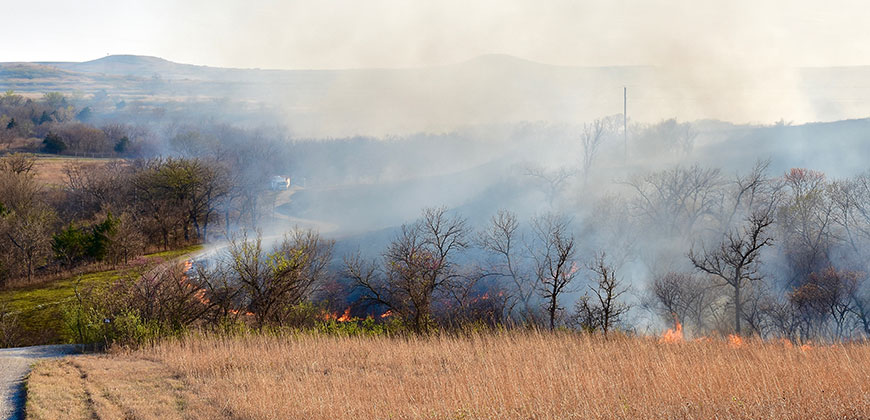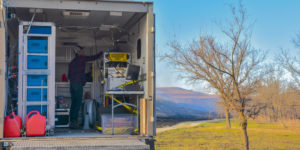
A controlled fire burns at the Konza Prairie Biological Station in Kansas. Credit: Barb Van Slyke/Kansas State University
When fires – accidental or controlled – burn across Colorado and surrounding states, billions of microscopic soot particles flutter into the atmosphere. If they rise high enough, and conditions are just right, these black carbon particles can trigger the formation of ice in clouds.
The composition and lifetime of clouds have major implications for weather and climate. Yet all the microphysics of how ice crystals form in clouds remain unclear, as do what sources – wildfires, dust storms or sea spray among them – contribute the most. Colorado State University atmospheric scientist Gregg Schill is seeking to isolate the relationship between clouds, and the black carbon from burning biomass. His goal: providing real data to help climate modelers predict critical climate effects in years to come.
Schill is a National Science Foundation postdoctoral fellow in the lab of Professor of Atmospheric Science Sonia Kreidenweis, and he works with Paul DeMott, a senior scientist in Kreidenweis’ group. Schill’s research is supported by the NSF Atmospheric and Geospace Sciences Postdoctoral Research Fellowship.
“We’re interested in measuring the specific contributions of black carbon to ice nucleating particles,” Schill said. “Ice nucleating particles have large implications for both precipitation and cloud radiative properties, and they form the basis for one of our largest uncertainties in the prediction of climate change.”
Real data, real fires
For data, Schill went straight to the source. Over several weeks this past summer, during the height of wildfire season, he drove several hours in many directions to places where the air was thick with smoke, dragging many pounds of equipment with him.

The CSU Mobile Air Quality Laboratory is a van stocked with specially designed, state-of-the-art aerosol sampling technology, including a continuous flow diffusion chamber and several particle measuring tools. A cylindrical cloud chamber mimics the properties of clouds at various altitudes, temperatures, pressures and humidities. Schill spent the summer sampling smoke-choked air in four-hour segments, counting soot particles and simulating in real time the fate of these particles inside “clouds.”
Schill and a team that included former postdoctoral researcher Kaitlyn Suski and chemistry graduate student Ethan Emerson drove to several fires. Among their stops: the Pioneer fire in Idaho; the Beaver Creek fire in Colorado; and the Cliff Creek fire in Wyoming. They also took data from a controlled burn at Konza Prairie Biological Station at Kansas State University, where research is regularly conducted on prescribed burning and the health of the tallgrass prairie ecosystem.
Prior to these field studies, Schill conducted initial experiments at the CSU Powerhouse Energy Campus’ Engines and Energy Conversion Laboratory, where he sampled exhaust from a diesel engine using the cloud chamber.
Schill is sifting through the reams of data taken during the field campaign to analyze the efficacy of black carbon for ice nucleation. He hopes the data can inform predictive climate models.
“If we’re going to understand what the climate will look like 50 years from now, we need to understand these cloud processes at the microphysical level,” Schill said.